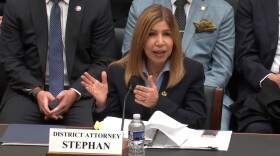A new energy storage project is rolling out across the county with the first two sites scheduled to break ground within the next month. This San Diego energy storage project aims to add more emissions, free energy to California's electric grid. Once completed, there will be a total of 12 sites across the county with enough storage to power, 110,000 homes for two hours. Joining me to talk about the new energy project at San Diego union Tribune, energy reporter, Rob Eski. Rob welcome.
Speaker 2: (00:29)
Hi Jade. Good talking to you again. Likewise,
Speaker 1: (00:31)
Could you tell us about the 12 new sites and how they'll work?
Speaker 2: (00:35)
Well, the batteries that are gonna be installed will store up energy and then release it into Cal California's power grid. Two of the sites will use zinc battery storage technology. The other 10 sites will use what's called lithium iron phosphate batteries. Now your listeners are probably familiar with lithium ion batteries. Now lithium iron phosphate is a little bit different. Uh, lithium iron phosphate batteries are considered less flamable. And so they're considered at least in this project to be, uh, a better choice. How
Speaker 1: (01:10)
Powerful will these sites be?
Speaker 2: (01:12)
Well, the entire portfolio is gonna count for 165 megawats and 336 megawat hours of battery storage, electricity. And as you mention that roughly translates into enough to power 110,000 homes for two hours.
Speaker 1: (01:28)
And what's the main goal of this project.
Speaker 2: (01:31)
The main goal of this project is the larger goal that California has, which is try to bring in more sources of power that do not emit greenhouse gas emissions. And, um, that that's because under the state's renewable portfolio standard, about 60% of California's electricity must come from renewable sources by 2030, and by 2045, if not earlier, a hundred percent of all the energy sources must come from carbon free sources. So that's a big driver behind this project and other ones.
Speaker 1: (02:03)
So if this project is successful, how does that change the trajectory of our climate crisis?
Speaker 2: (02:09)
Well, the thought is that if you're able to use battery storage, that that can help replace some of the fossil fuel sources that are out there. And the overall trick to this whole thing is that here in California, we have a lot of solar production that we get during the day. In fact, we get so much solar production that it can't be used, that sometimes it has to be curtailed. And so what they're trying to do is be able to take that excess solar or any other excess power that we have during the day, then store that up and use batteries to that. Then when solar production declines rapidly, once the sun goes down, you might be able to deploy. You will be able to deploy, um, energy from batteries and other sources like that, that can store up energy. So this whole idea of energy storage is very critical for California to try to meet these climate goals.
Speaker 1: (03:03)
And we know the first two sites are breaking ground within the next month in Chula Vista and El Cajon. Where will the other 10 sites be located in the county?
Speaker 2: (03:12)
They'll be scattered all across the county. There's one, a fairly decent size in LA Mesa. Another one, fairly decent size in spring valley. The, uh, second largest project is 30 megawats, uh, and that's out in Rancho Pena Quintos and then the biggest will be built out in Ramona and that'll be 39 megawatts. Hmm. So
Speaker 1: (03:33)
When are all the sites expected to be up and running?
Speaker 2: (03:36)
Well, the El Caho Chula Vista site that you mentioned at the, uh, top of this, uh, interview that are just broken ground, they're expected to begin commercial operations. As soon as early April of the entire portfolio, they expect to have all 12 sites up and running by the end of 2023.
Speaker 1: (03:53)
And could you tell us about who will be designing and operating these systems?
Speaker 2: (03:58)
It's this company that it's based in San Diego called enter smart. Uh, they're a renewable energy company. Uh, they're fairly new. I wrote a story about them about a year ago, about another project that they're doing in the San Diego area. And it's not as big, but, uh, they're new, but they're making, um, making some progress here.
Speaker 1: (04:18)
All right. How much is the project to cost and how will it be funded?
Speaker 2: (04:23)
It's estimated to cost up to a hundred million and enter smart, was able to get some funding, some financing from two pretty big, uh, entities. One is Siemens financial. The other is in north American development bank. They're going to split the call us about 50 50 between Siemens and the north American development bank. The north American development bank is kind of interesting. It's a binational project that's been established by the us and Mexico government that's been established in order to, uh, build and enhance infrastructure projects along the border of those two countries.
Speaker 1: (05:01)
Do you foresee more projects like this rolling out across the county or even the state in the near future?
Speaker 2: (05:08)
Yeah, I think so. In fact, definitely it's probably a better way to put it because of those California renewable mandates that we talked about earlier. There's a lot of requirements and there's a lot of push to bring more renewable projects into the form, put 'em into the grid. And on top of that, the public utilities commission has ordered utilities and power companies to come up with more sources of power, especially clean energy projects in the next few years, the grid really needs these new projects, especially because us in the next couple of years, the last remaining nuclear power plant in California, the Yalo canyon power plant up in, uh, central California. That's going to be going away. It's going to be a discontinued and that's roughly about 2000 megawats that need to be replaced. So California is looking for more in the next couple year, more sources of power, especially clean power.
Speaker 1: (06:06)
All right. So we know one of the big goals of this project is to be able to store and use this emissions free energy more efficiently. Does this have the prospect of low lowering energy bills at all?
Speaker 2: (06:19)
At this point? I, I doubt it because the general thought is that this particular project that we're talking about that inner Smartt is doing, I ask, uh, the managing partner of that company, what the estimated cost would be. And it's about $300 per megawat hour, which is more expensive than conventional sources. But the overall thought that, uh, backers of energy storage say is that they point to the fact that energy storage battery storage prices have dramatically gone down. Uh, few years ago, it was in the tens of thousands of dollars. Now it's depending, uh, on the various estimate that have been said, for example, the national renewable energy, uh, laboratory in Colorado, they estimate that by the year 2030, that battery storage prices could be about $148 megawat hour. So the goal is to get to battery storage prices at about a hundred dollars in megawat. So we're getting closer, but I don't think that this particular project will translate into, uh, lower energy bills for customers in San Diego. Right now
Speaker 1: (07:28)
I've been speaking with San Diego union Tribune energy reporter, Rob Eski, Rob, thank you so much for joining us. Thank you.







